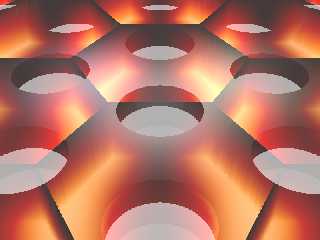|
 |
"Bald Eagle" <cre### [at] netscape net> wrote:
> I had that as part of a mental list to post, but it slipped off...
>
> I was also thinking that if you wanted to represent an emission, you ought to
> use the standard lambda-photon-sine-wave thing
>
> like
> https://physics.aps.org/assets/5f985b1a-28d8-4cb1-89f1-1ae7dedeac6f/e135_2_thumb.png
>
> Just define it as an object that you can replace that quickie Vector () with.
>
> And now I'm off to lunch.
So for the fast case I managed to get rid of the overlap by defining the field
directly in a prism that I scale to the unit cell size, like this
#declare Field_object = prism {
linear_sweep
linear_spline
0., // sweep the following shape from here ...
1., // ... up through here
7, // the number of points making up the shape ...
<0.,0.5>, <0.25,1.>, <0.75,1.>, <1.,0.5>, <0.75,0.>, <0.25,0.>, <0.,0.5>
texture {
finish { diffuse 0 ambient 0 reflection 0 }
pigment {
colour rgbft <1.000,1.000,1.00,0.000,1.000>
}
}
hollow
interior{
ior 1.000
caustics 0.000
dispersion 1.000
dispersion_samples 7.000
fade_power 0.000
fade_distance 0.000
fade_color rgb <0.000,0.000,0.000>
// Red
media {
method 3
intervals 10
samples 1, 1
confidence 0.900
variance 0.008
ratio 0.900
absorption rgb <0,0,0>
emission rgb <1,0,0> * Field_brightness
aa_threshold 0.050
aa_level 4
density {
density_file df3 "efield_energy_in_superspace_R.df3"
interpolate Field_interpolation
}
}
// Green
media {
method 3
intervals 10
samples 1, 1
confidence 0.900
variance 0.008
ratio 0.900
absorption rgb <0,0,0>
emission rgb <0,1,0> * Field_brightness
aa_threshold 0.050
aa_level 4
density {
density_file df3 "efield_energy_in_superspace_G.df3"
interpolate Field_interpolation
}
}
// Blue
media {
method 3
intervals 10
samples 1, 1
confidence 0.900
variance 0.008
ratio 0.900
absorption rgb <0,0,0>
emission rgb <0,0,1> * Field_brightness
aa_threshold 0.050
aa_level 4
density {
density_file df3 "efield_energy_in_superspace_B.df3"
interpolate Field_interpolation
}
}
media {
absorption 0.
}
}
// Set proper size and position
scale field_box_dim
translate field_box_trans
}
But still a problem is that the "black" parts of the color map are not
transparent (maybe because the density is not exactly 0.0?). So there is a kind
of "box" still visible, which destroys the complete image. See the attachment.
Help! :)
For the emitter thing: yes that "standard lambda-photon-sine-wave thing" would
really be a great thing to have ... er ... how do I do that? :) net> wrote:
> I had that as part of a mental list to post, but it slipped off...
>
> I was also thinking that if you wanted to represent an emission, you ought to
> use the standard lambda-photon-sine-wave thing
>
> like
> https://physics.aps.org/assets/5f985b1a-28d8-4cb1-89f1-1ae7dedeac6f/e135_2_thumb.png
>
> Just define it as an object that you can replace that quickie Vector () with.
>
> And now I'm off to lunch.
So for the fast case I managed to get rid of the overlap by defining the field
directly in a prism that I scale to the unit cell size, like this
#declare Field_object = prism {
linear_sweep
linear_spline
0., // sweep the following shape from here ...
1., // ... up through here
7, // the number of points making up the shape ...
<0.,0.5>, <0.25,1.>, <0.75,1.>, <1.,0.5>, <0.75,0.>, <0.25,0.>, <0.,0.5>
texture {
finish { diffuse 0 ambient 0 reflection 0 }
pigment {
colour rgbft <1.000,1.000,1.00,0.000,1.000>
}
}
hollow
interior{
ior 1.000
caustics 0.000
dispersion 1.000
dispersion_samples 7.000
fade_power 0.000
fade_distance 0.000
fade_color rgb <0.000,0.000,0.000>
// Red
media {
method 3
intervals 10
samples 1, 1
confidence 0.900
variance 0.008
ratio 0.900
absorption rgb <0,0,0>
emission rgb <1,0,0> * Field_brightness
aa_threshold 0.050
aa_level 4
density {
density_file df3 "efield_energy_in_superspace_R.df3"
interpolate Field_interpolation
}
}
// Green
media {
method 3
intervals 10
samples 1, 1
confidence 0.900
variance 0.008
ratio 0.900
absorption rgb <0,0,0>
emission rgb <0,1,0> * Field_brightness
aa_threshold 0.050
aa_level 4
density {
density_file df3 "efield_energy_in_superspace_G.df3"
interpolate Field_interpolation
}
}
// Blue
media {
method 3
intervals 10
samples 1, 1
confidence 0.900
variance 0.008
ratio 0.900
absorption rgb <0,0,0>
emission rgb <0,0,1> * Field_brightness
aa_threshold 0.050
aa_level 4
density {
density_file df3 "efield_energy_in_superspace_B.df3"
interpolate Field_interpolation
}
}
media {
absorption 0.
}
}
// Set proper size and position
scale field_box_dim
translate field_box_trans
}
But still a problem is that the "black" parts of the color map are not
transparent (maybe because the density is not exactly 0.0?). So there is a kind
of "box" still visible, which destroys the complete image. See the attachment.
Help! :)
For the emitter thing: yes that "standard lambda-photon-sine-wave thing" would
really be a great thing to have ... er ... how do I do that? :)
Post a reply to this message
Attachments:
Download 'phc_and_excitation_enhancement.png' (250 KB)
Preview of image 'phc_and_excitation_enhancement.png'

|
 |




![]()